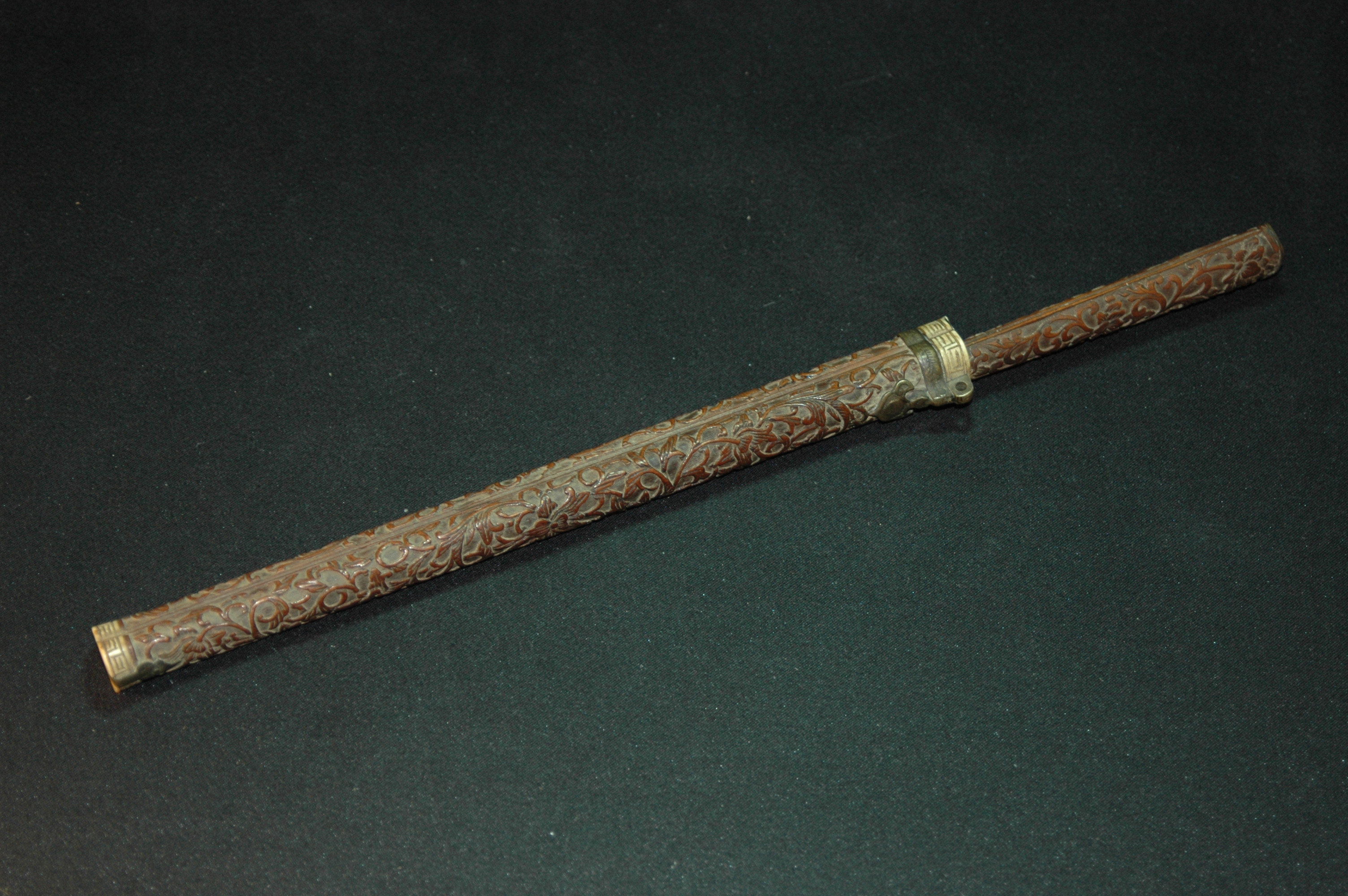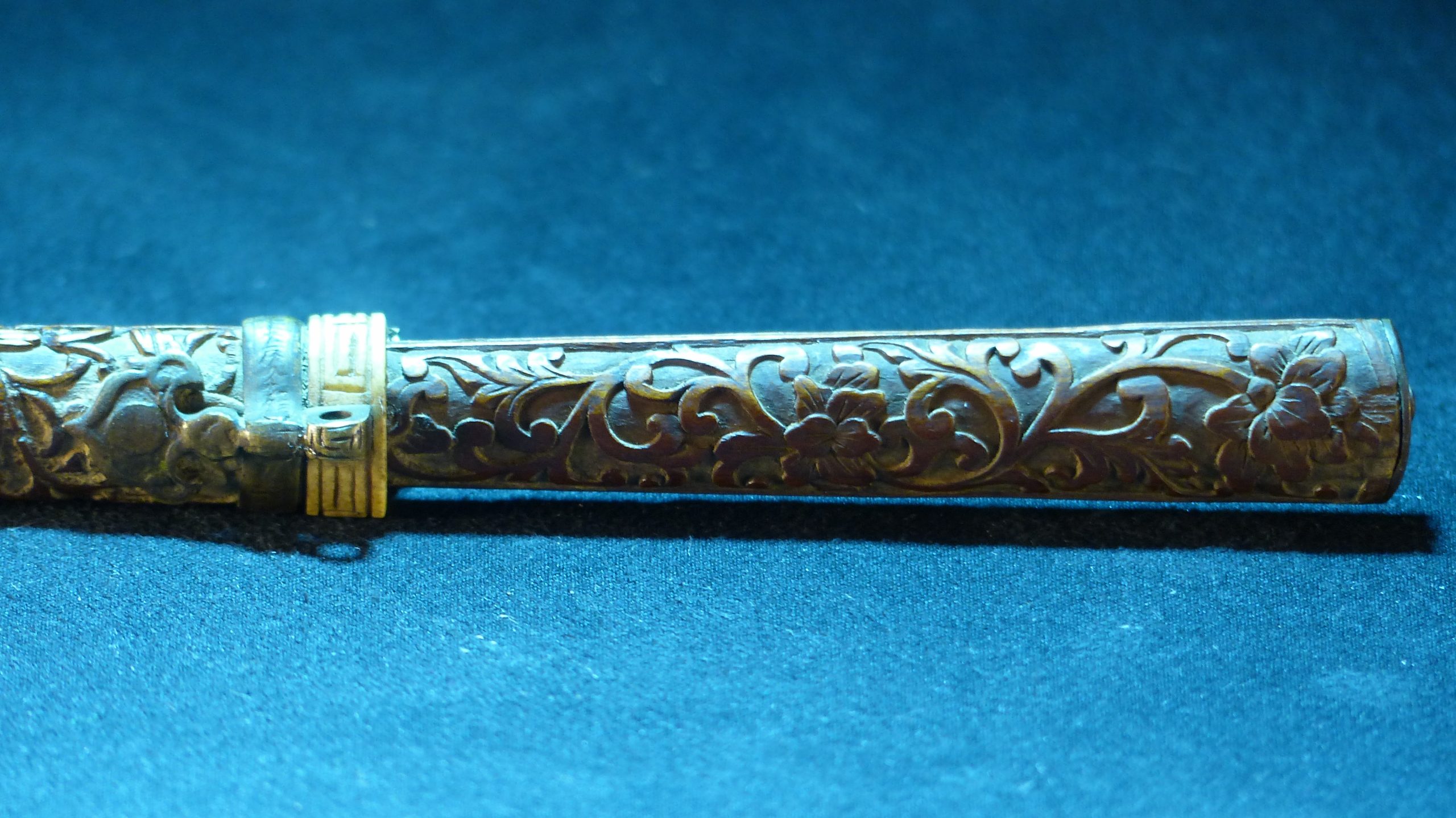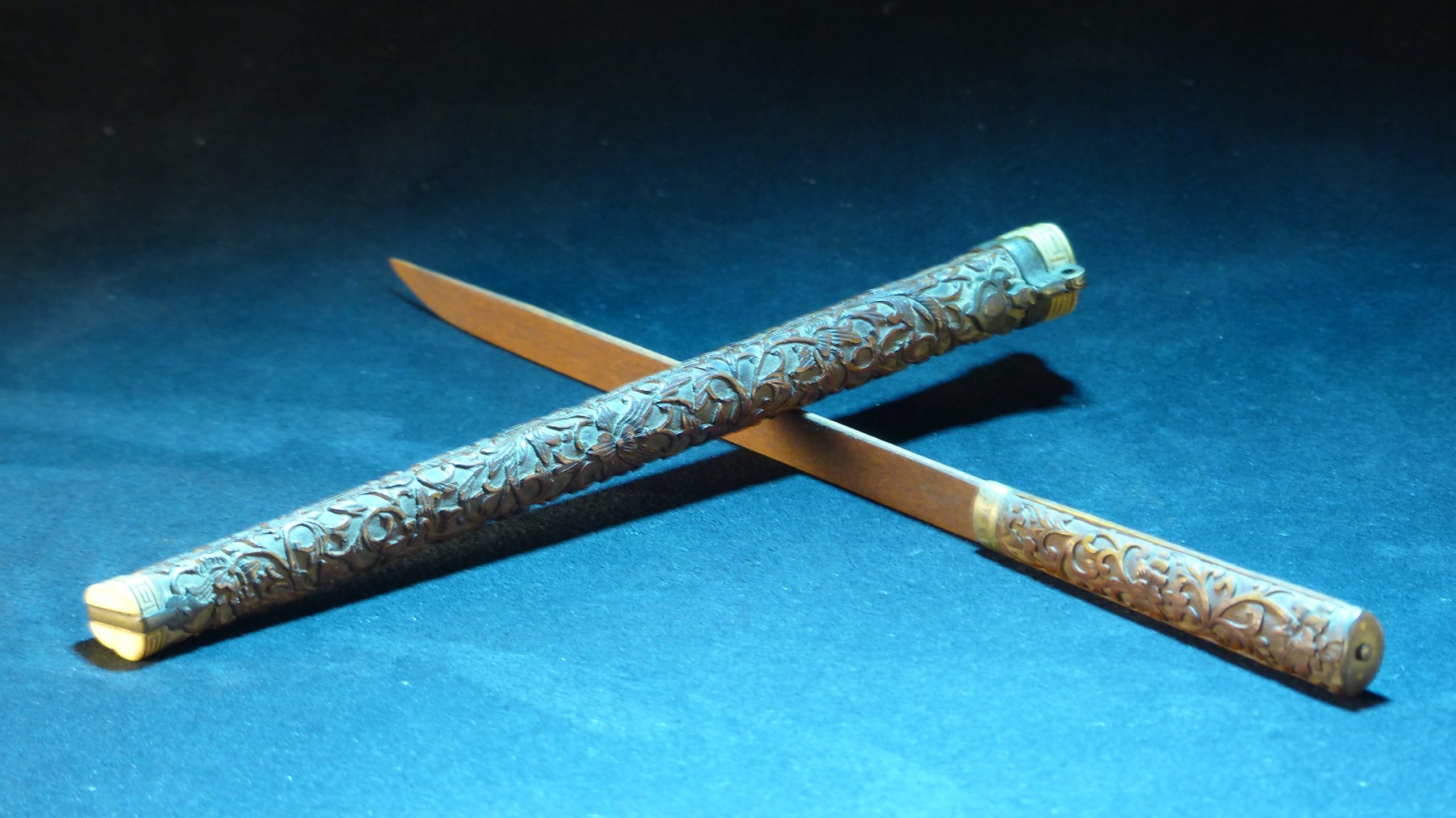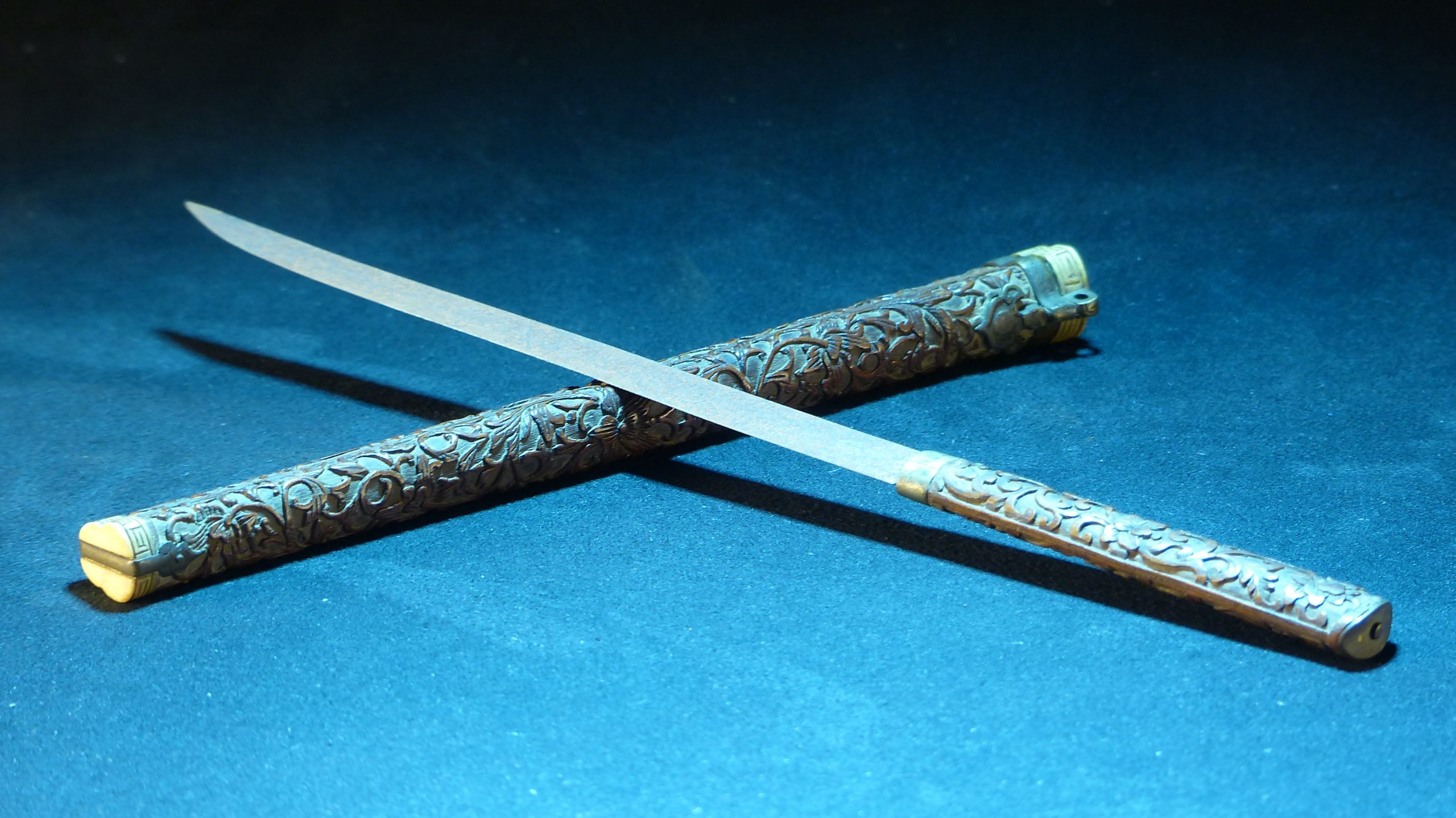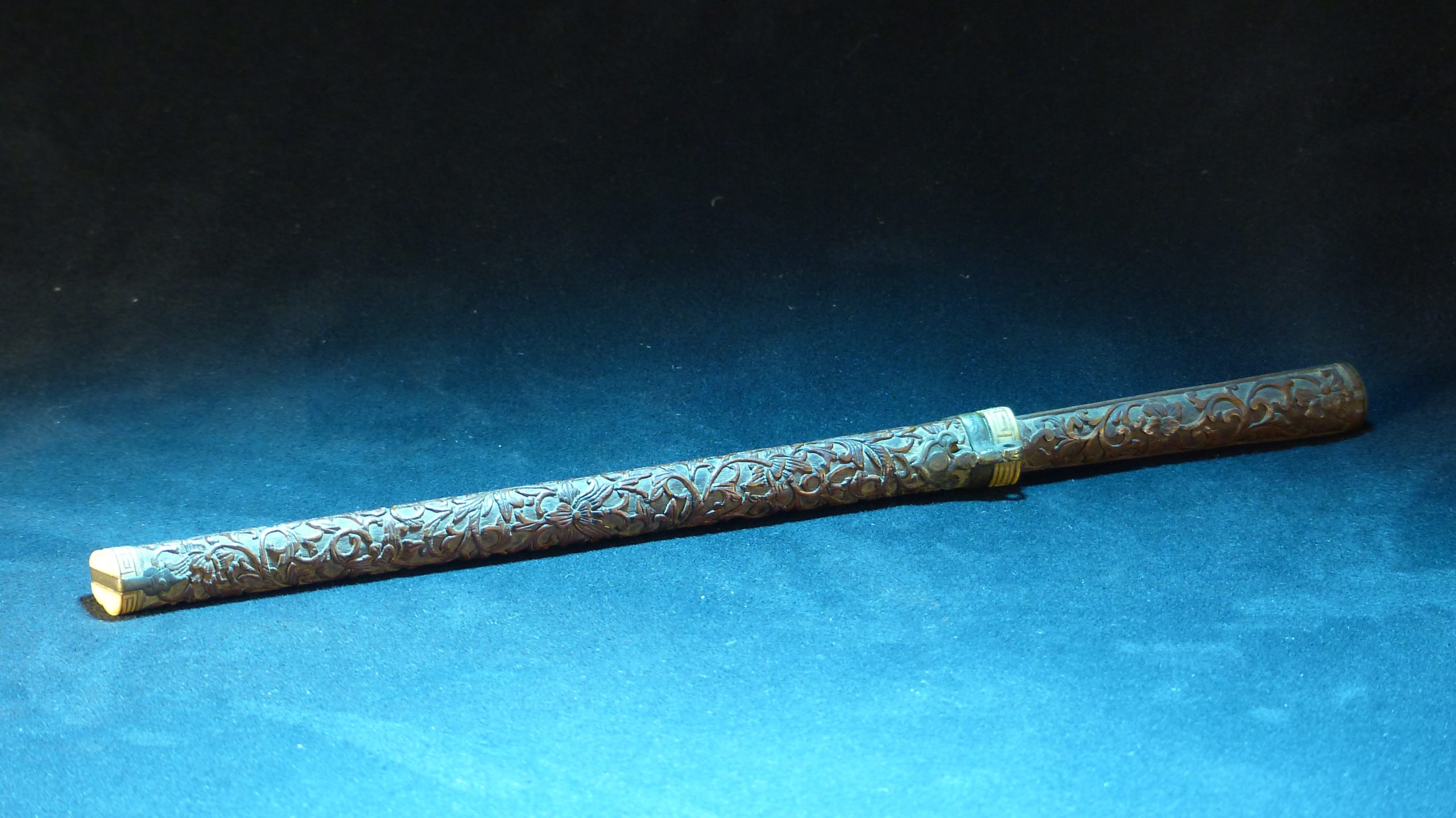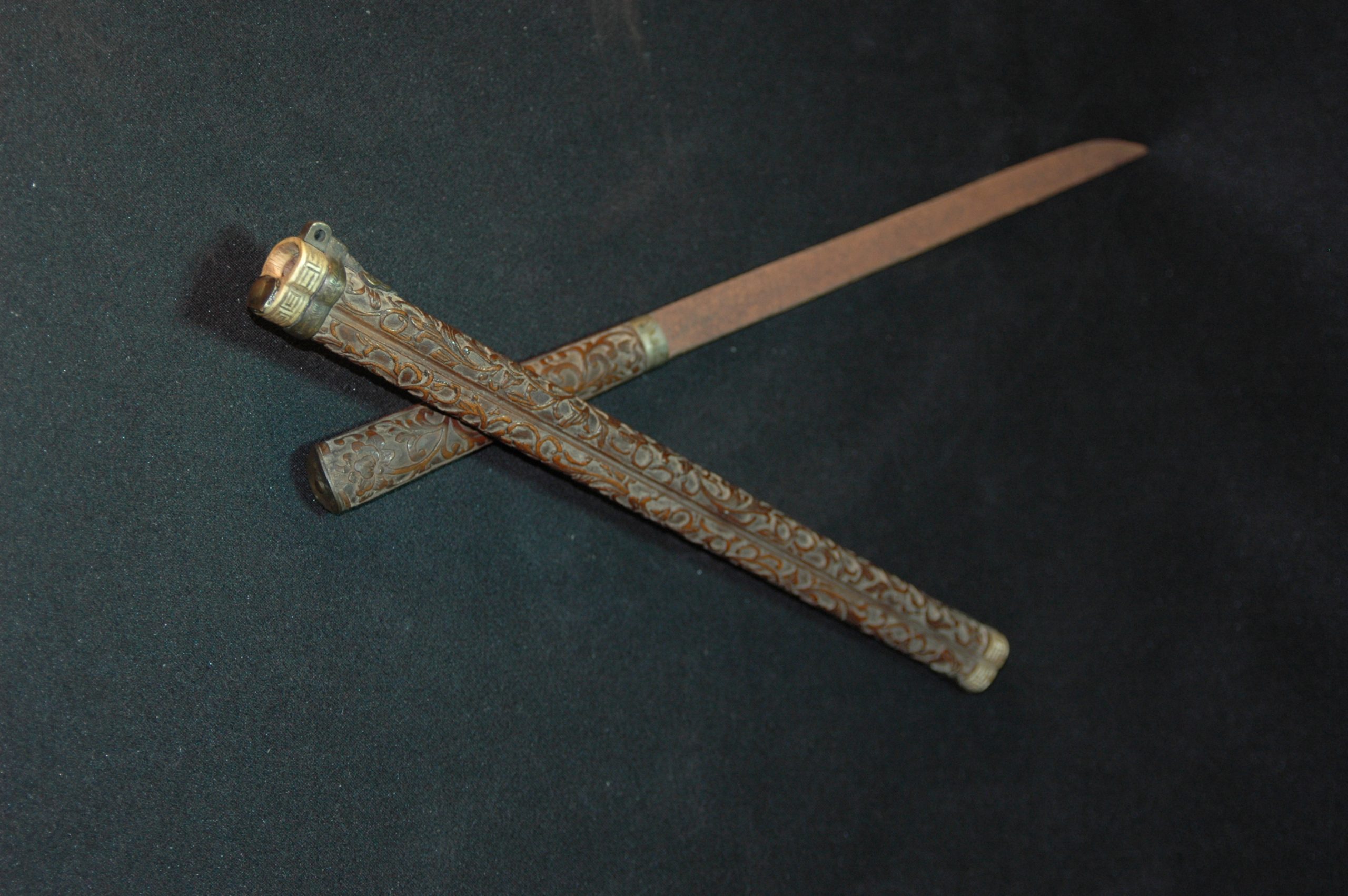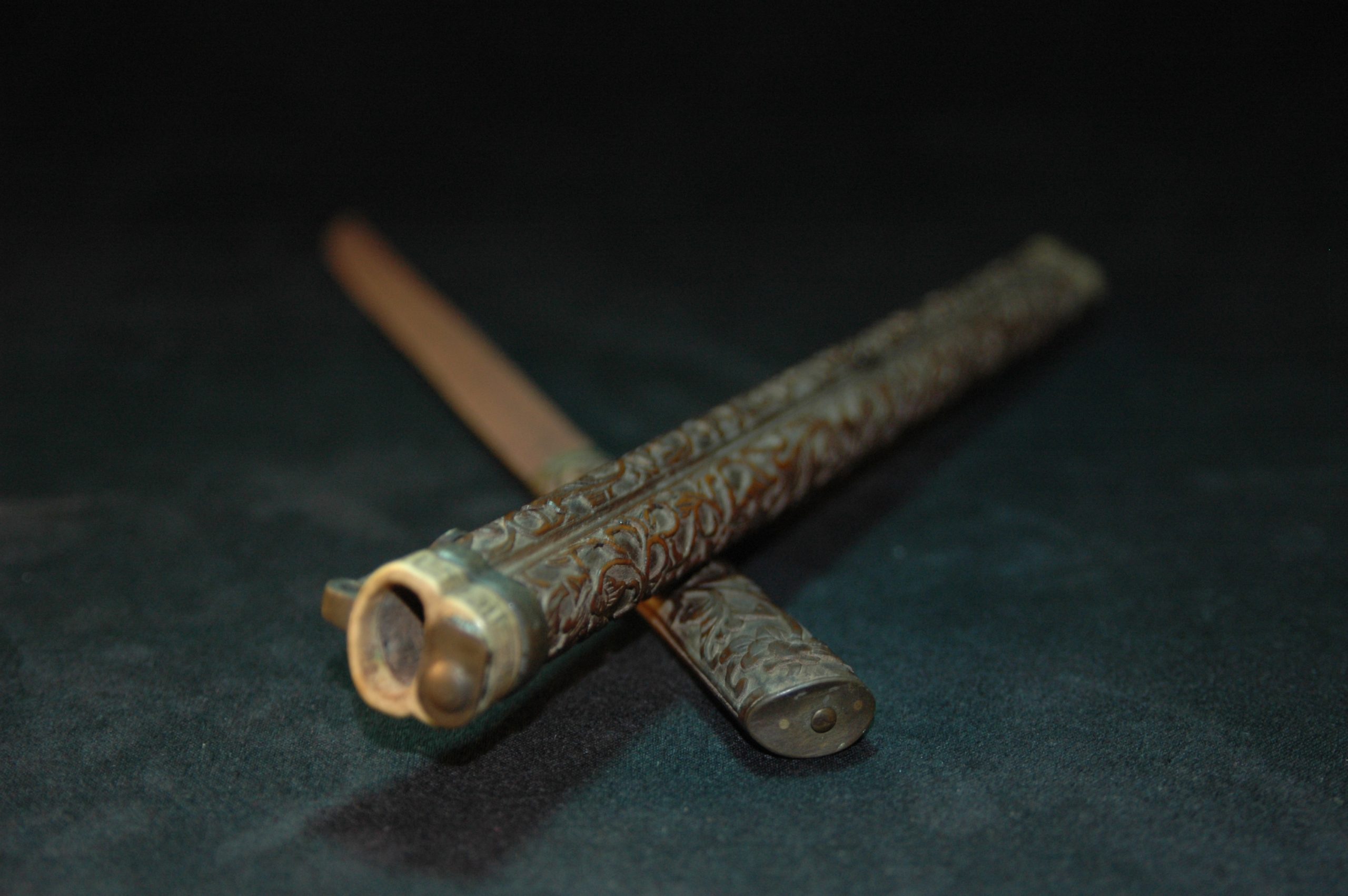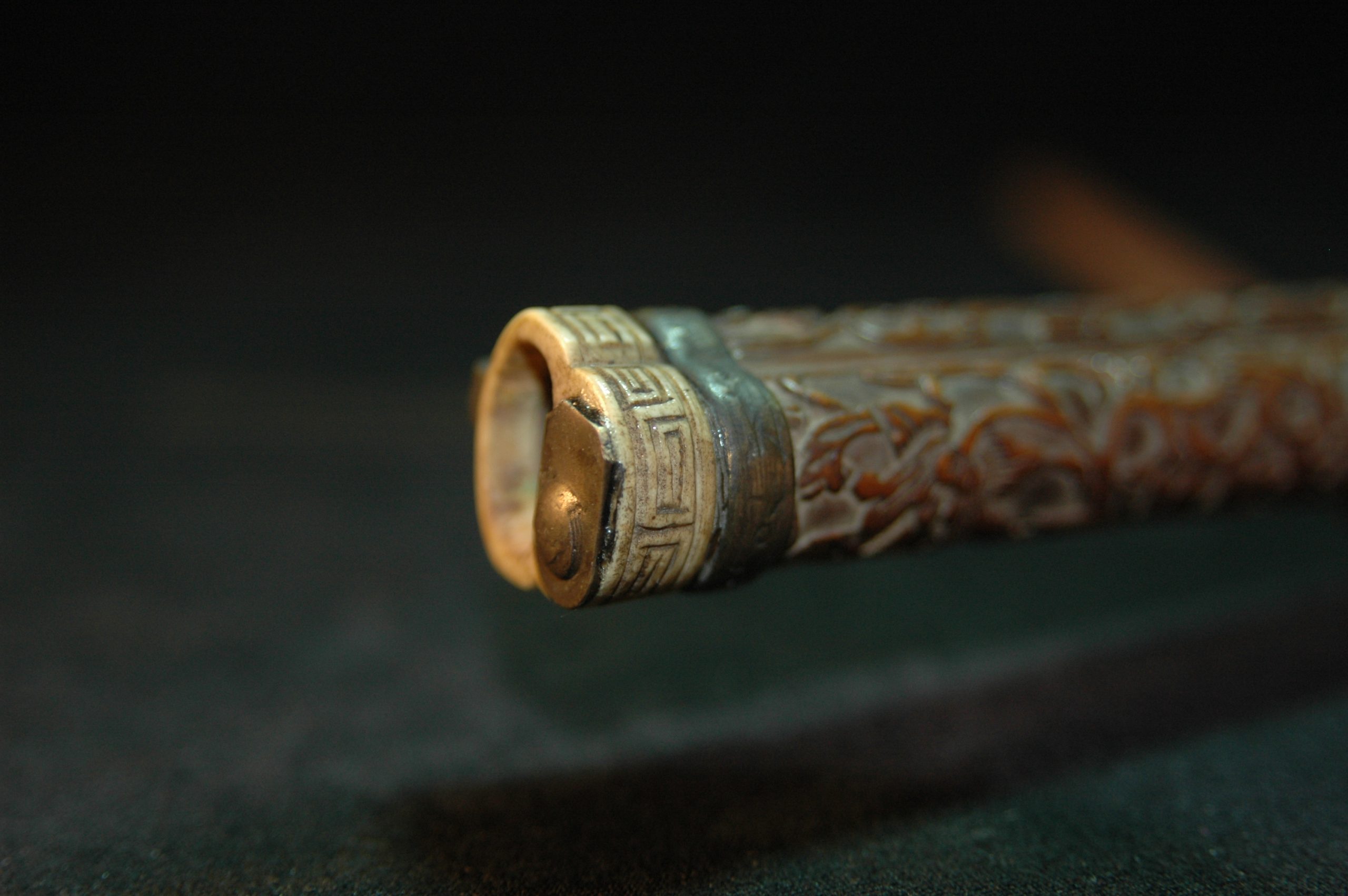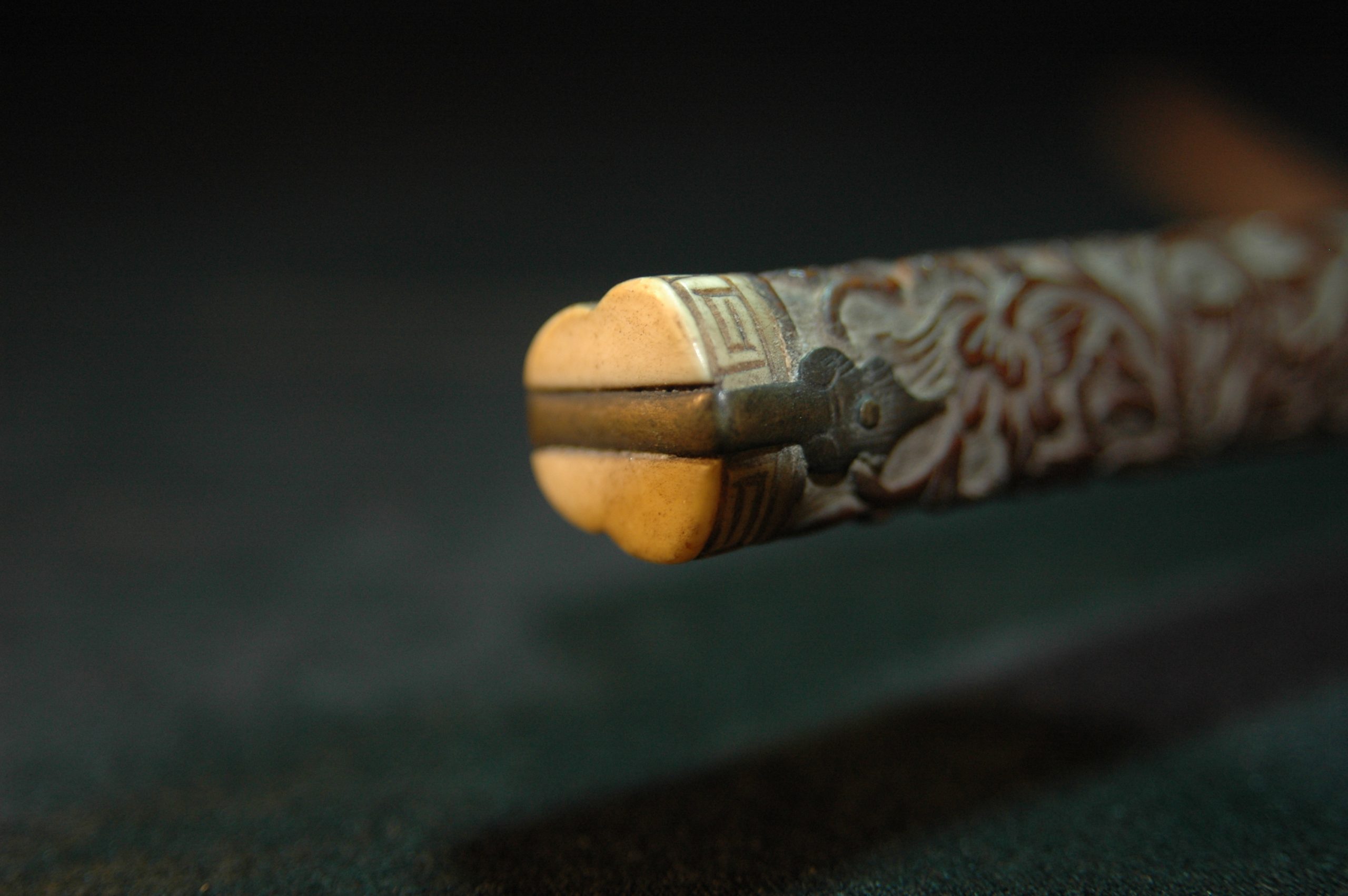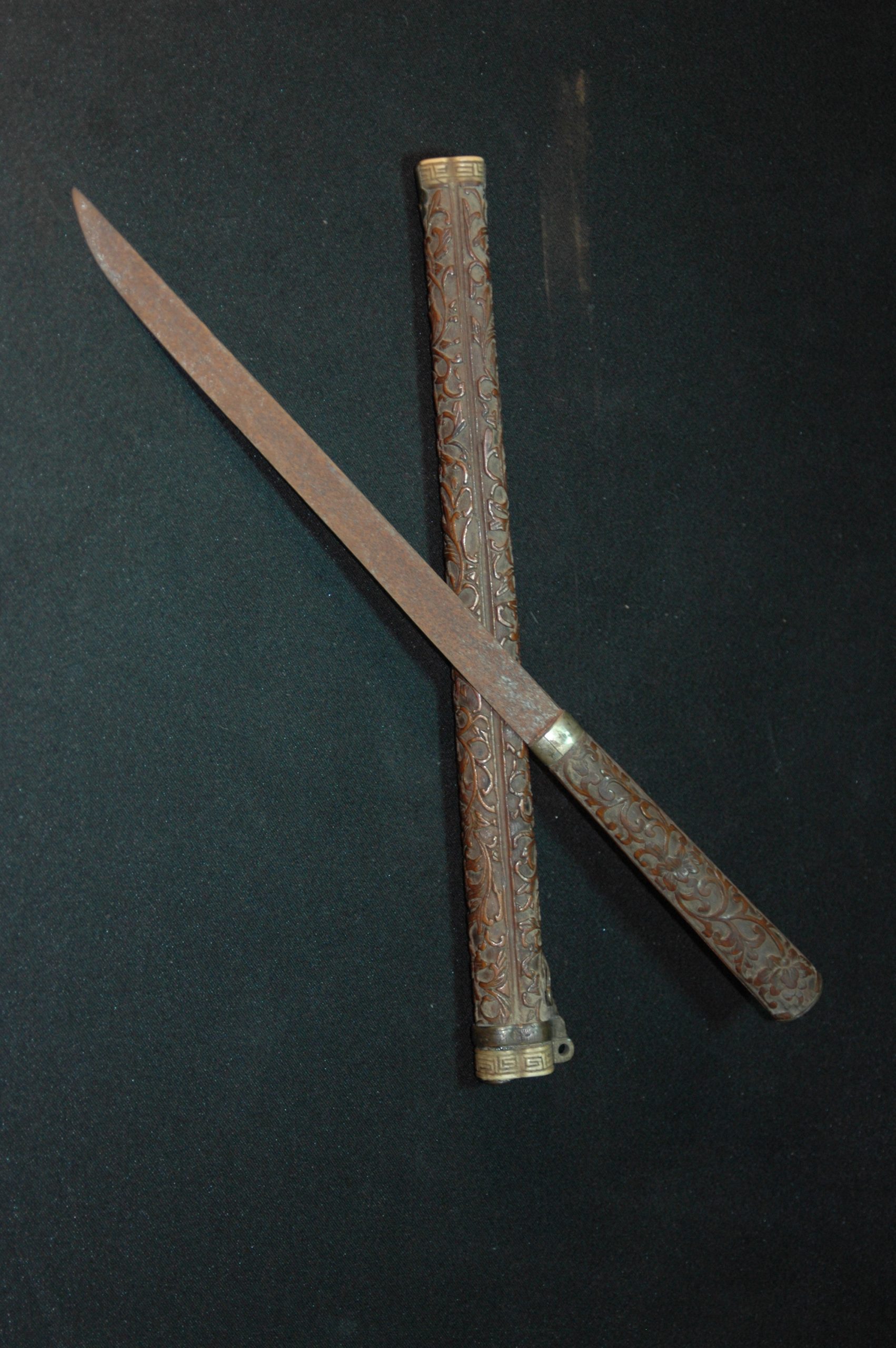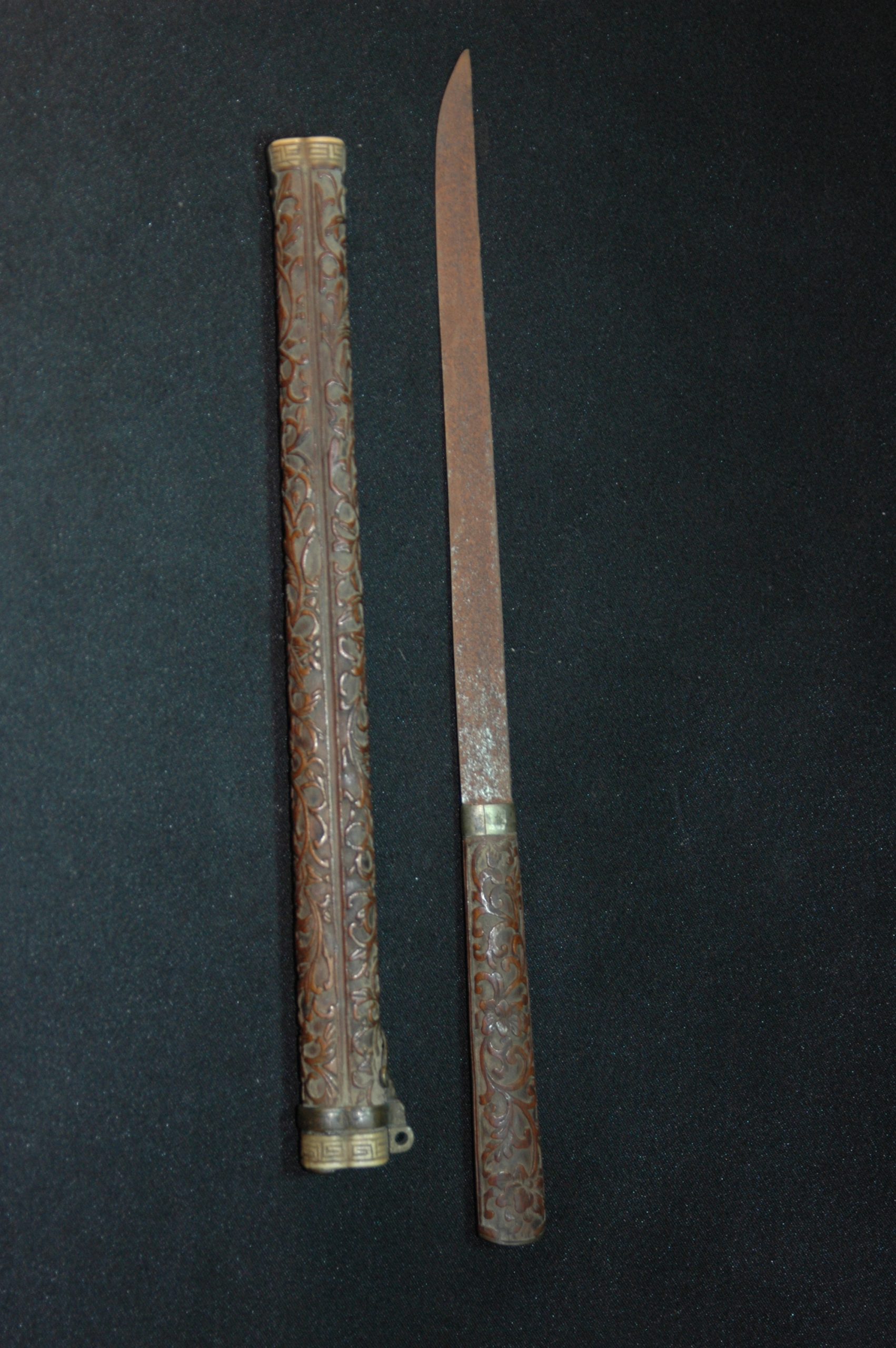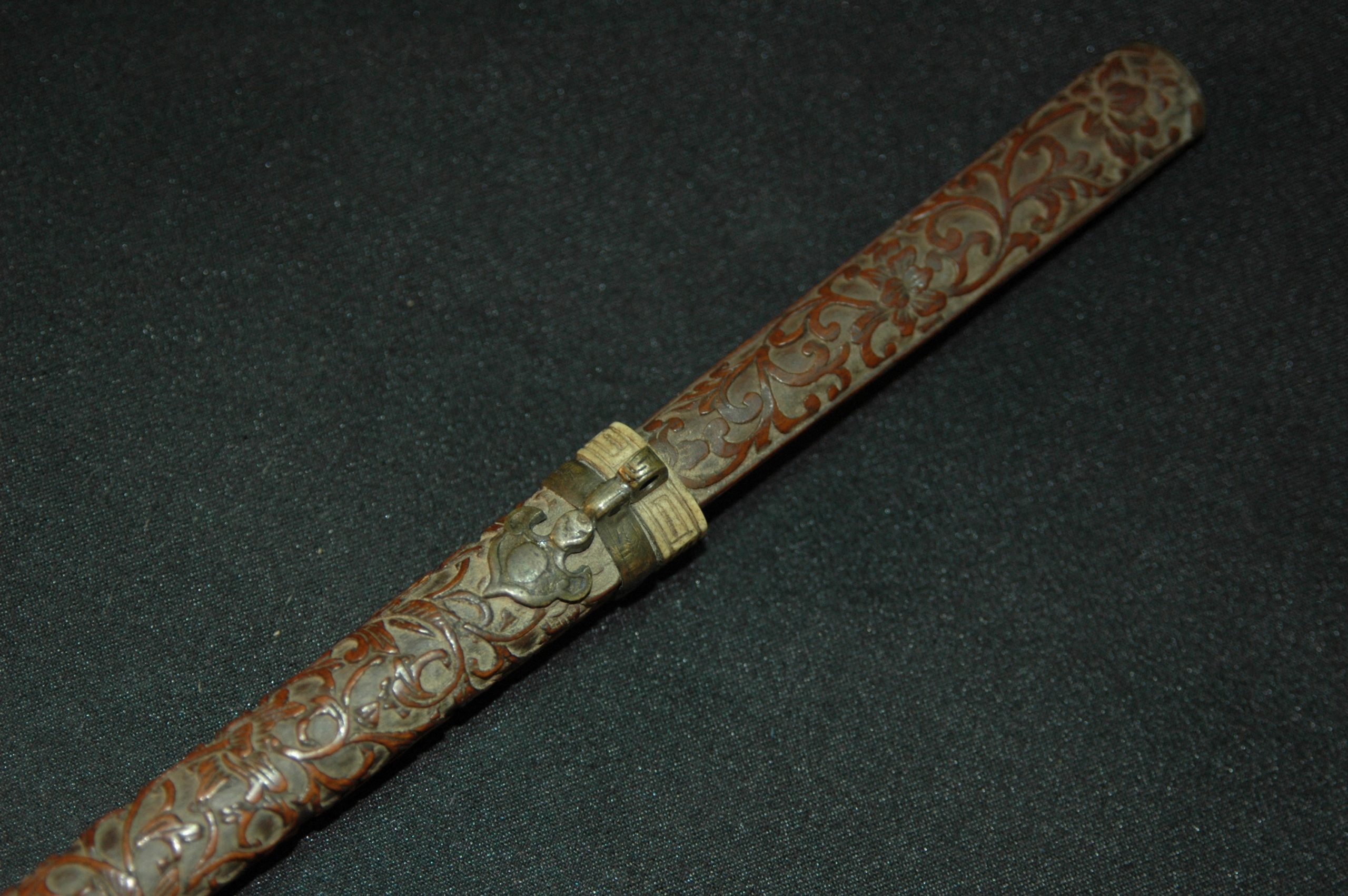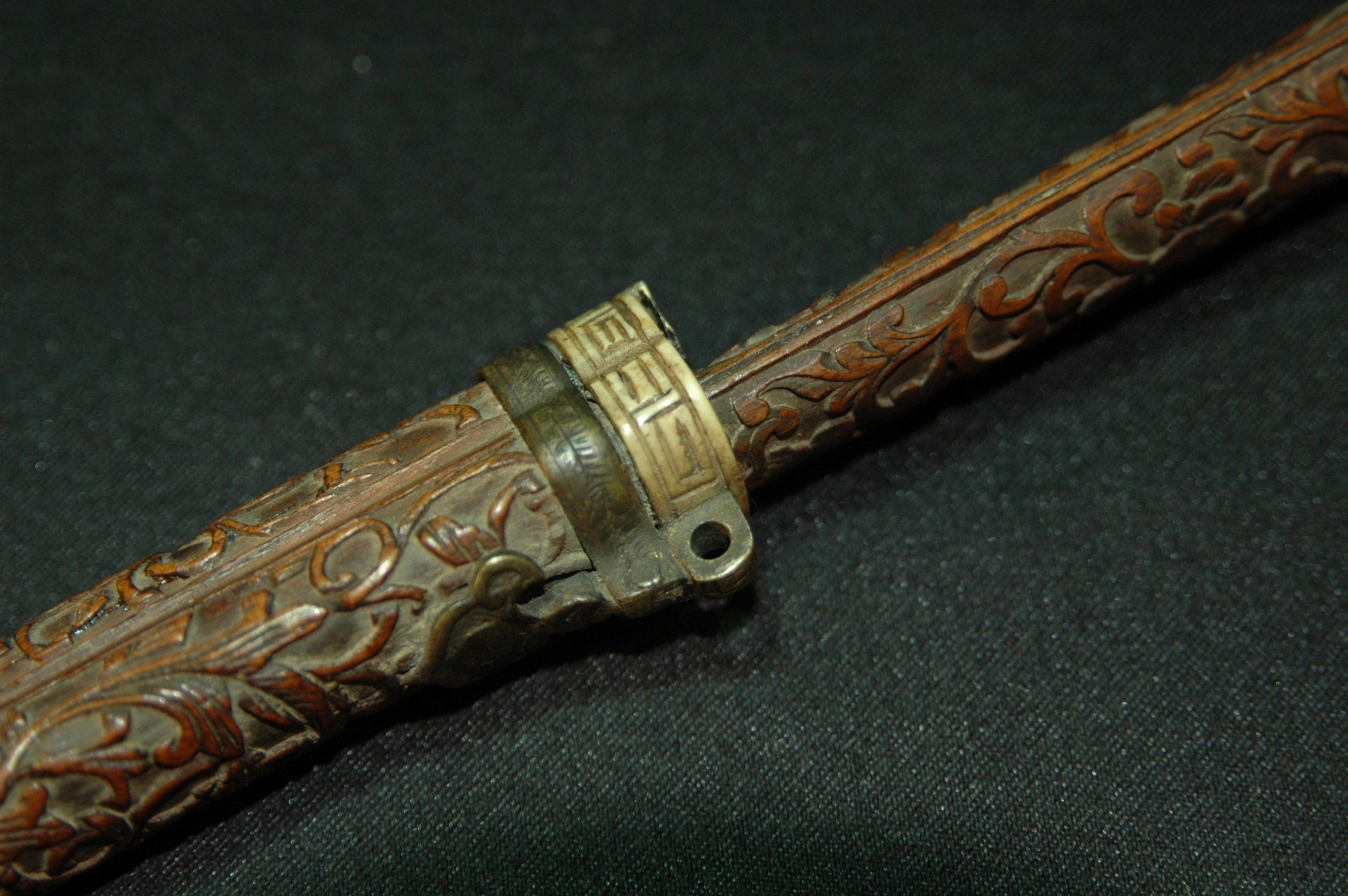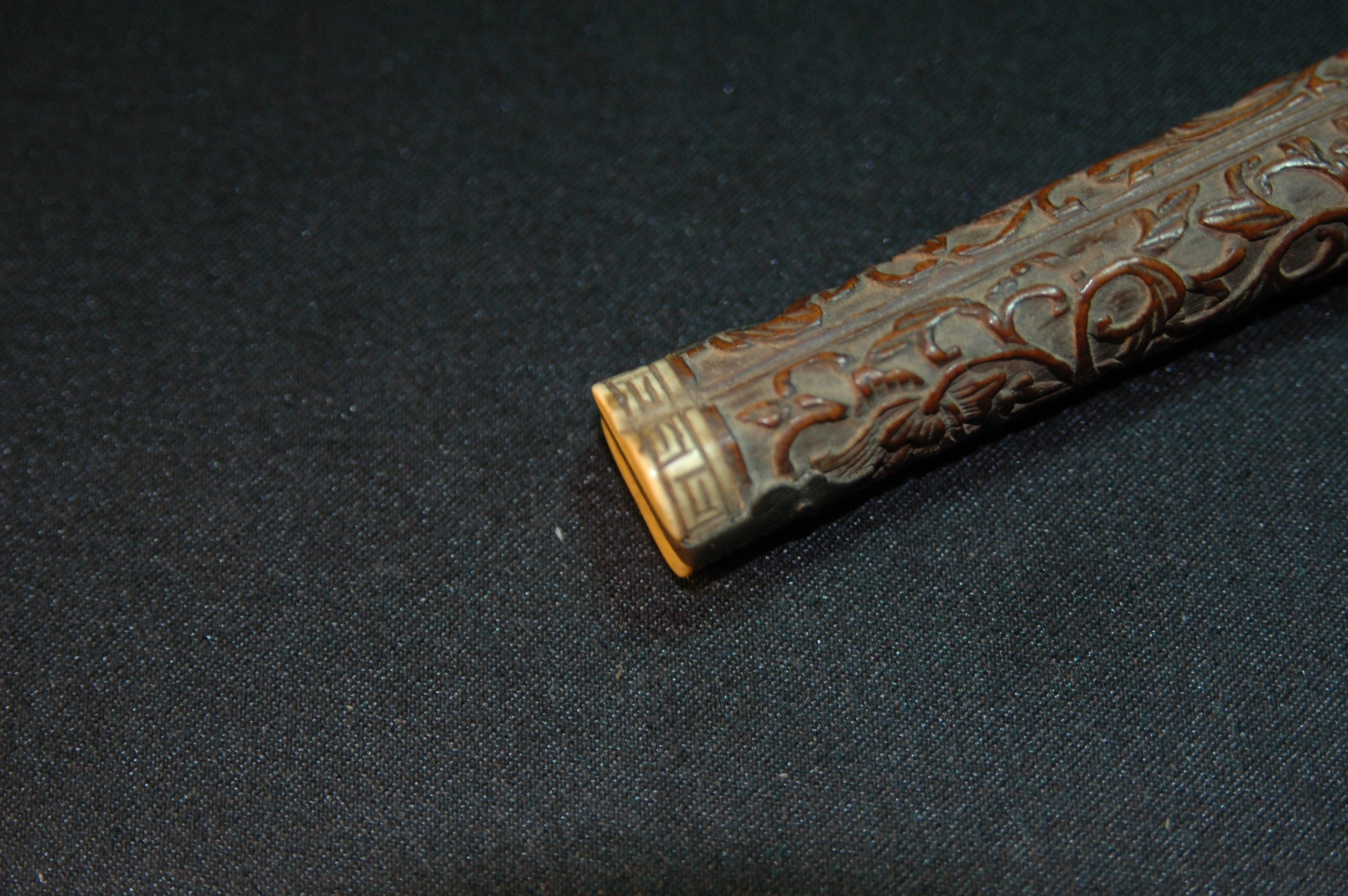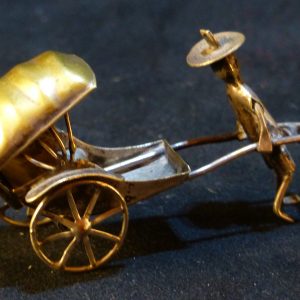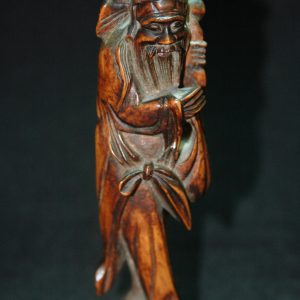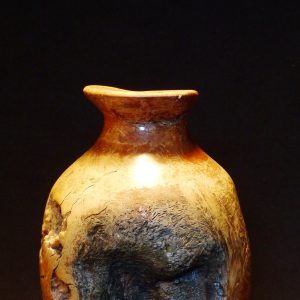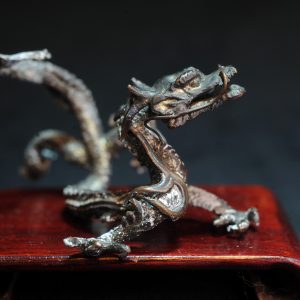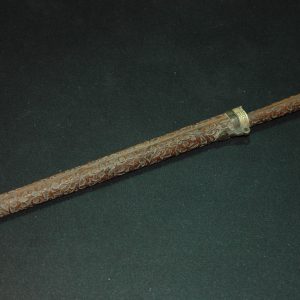Description
清 雕犀角象牙缠枝牡丹纹蒙古隨身刀 蒙古王爷刀
参考:故宫 清中期犀角雕云龙纹嵌宝石髓羚羊角柄小刀
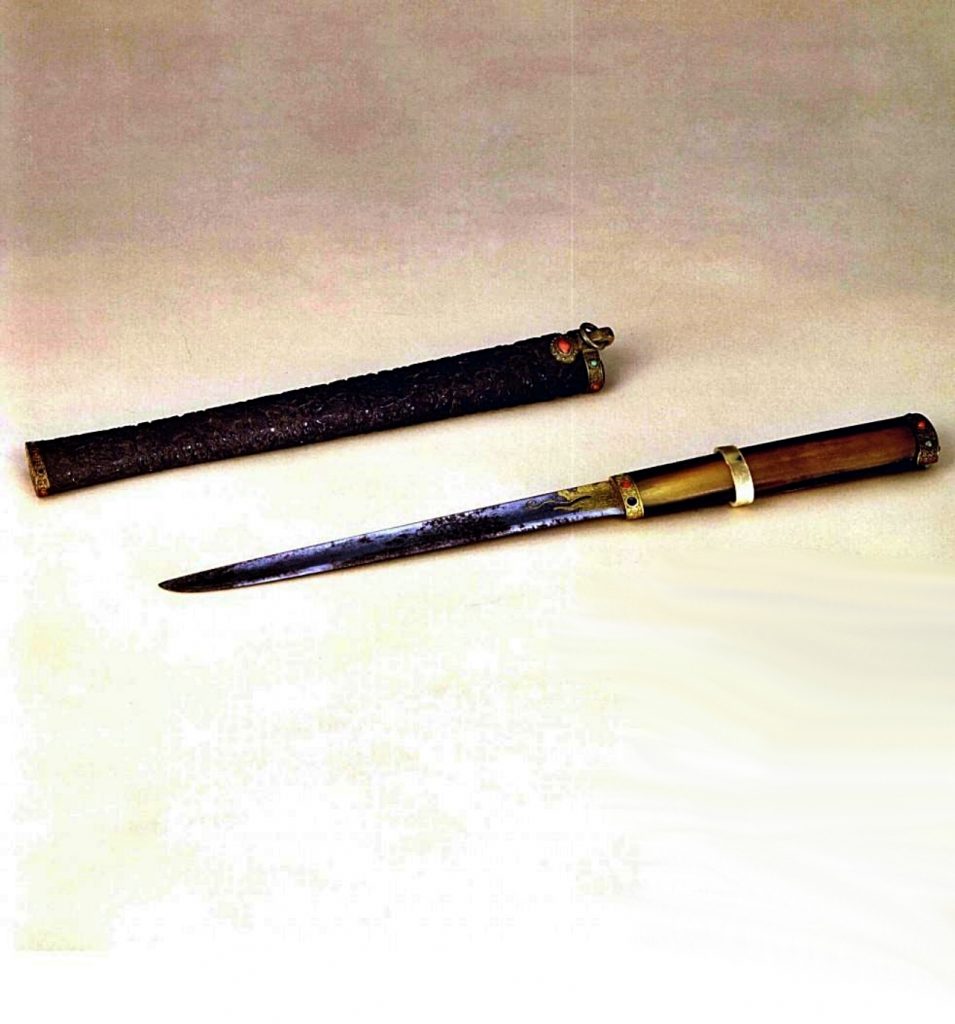
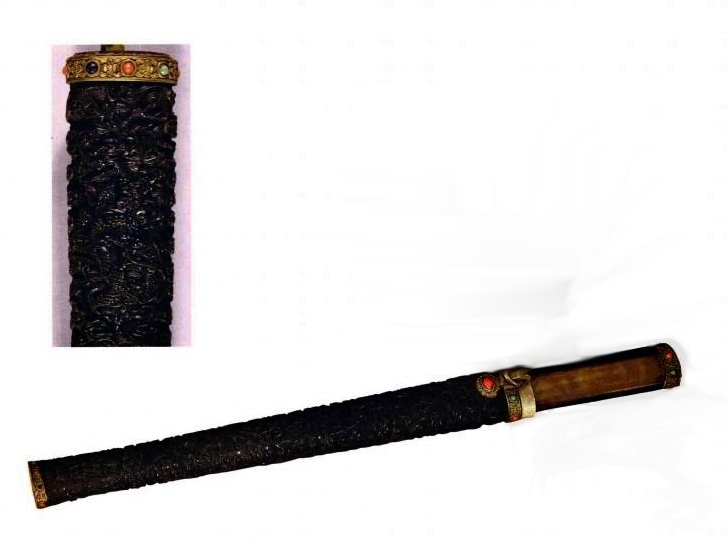
长28.9厘米
刀箱为犀角浮雕而成,狭长,稍稍束腰,线条优美,正背面各雕三条龙纹,并以云水为衬。刀柄则为羚羊角制成,光素无纹,内挖空槽分储金画慑子、耳勺、象牙牙签各一。铜绪金嵌石柄首,可开启为盖。象牙制椭圆环,套于柄上,恰成格状。办锋笑说。有需金曾纹吞口。柄与鞘上之铜活袭饰均金鉴花,镶红、绿、蓝三色石料,其工艺有蒙裁地区的风格。此器将多种材质汇集一身,是一件颇具特点的器具。
小刀鞘上犀角雕刻深受当时牙雕工艺的影响,细腻人微,构图繁复,在很小的浮雅高度内划分出多个层次。从清宫《活计档》中我们可以找到乾隆二十年六月十二日”如意馆”条下“着苦兆所作乌角雕来龙小力鞘周围往精细里收拾”的记录,证明此类作品确有可能出自牙雕匠人之手。而乾隆十九年三月二十七日“如意馆”条提到的“犀角商丝鞘花羊角靶小刀”则亦当与此作十分接近
参考:佳士得
8 6月 2021 | 現場拍賣 19974
亞洲藝術
拍品 259 清十八世紀 藍透明琺琅嵌玉及象牙刀
COUTEAU EN JADE, EMAUX DE CANTON DE BASSE TAILLE ET IVOIRE
CHINE, DYNASTIE QING, XVIIIEME SIECLE
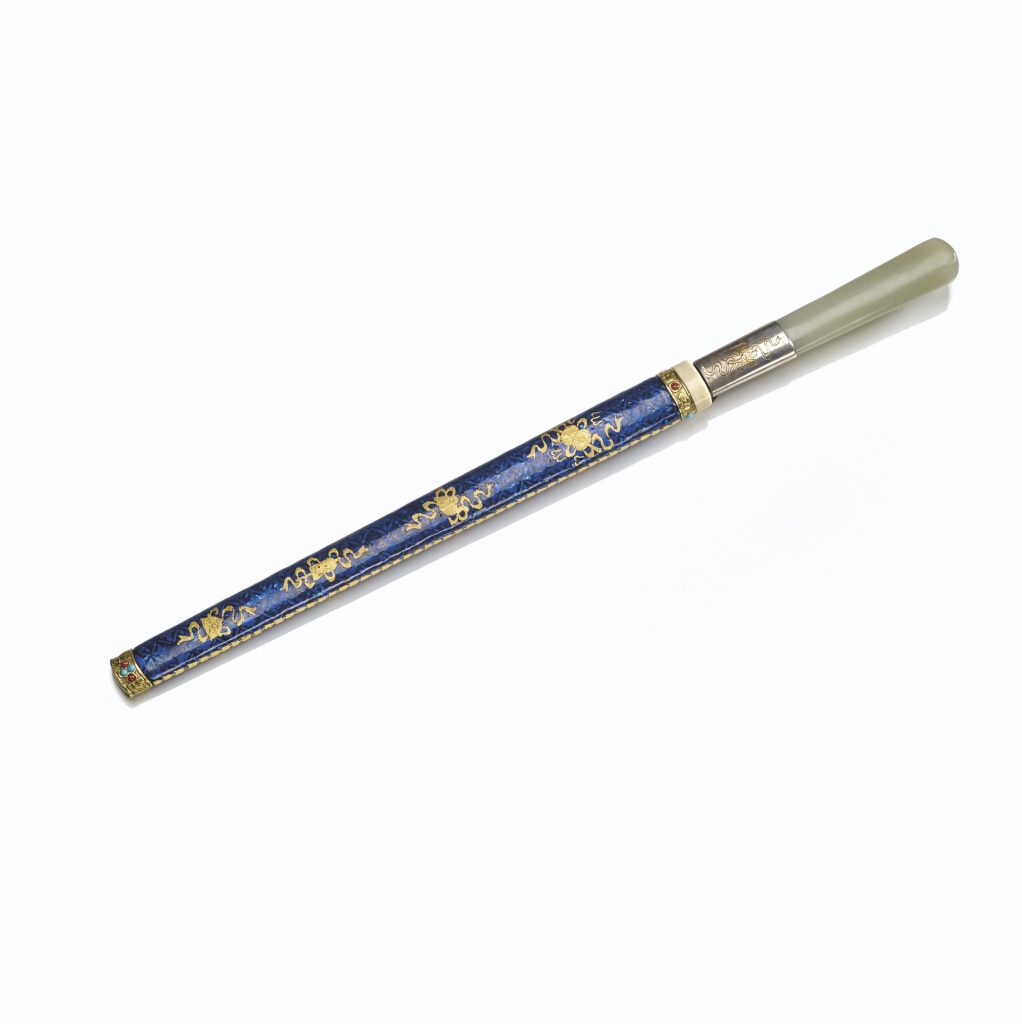
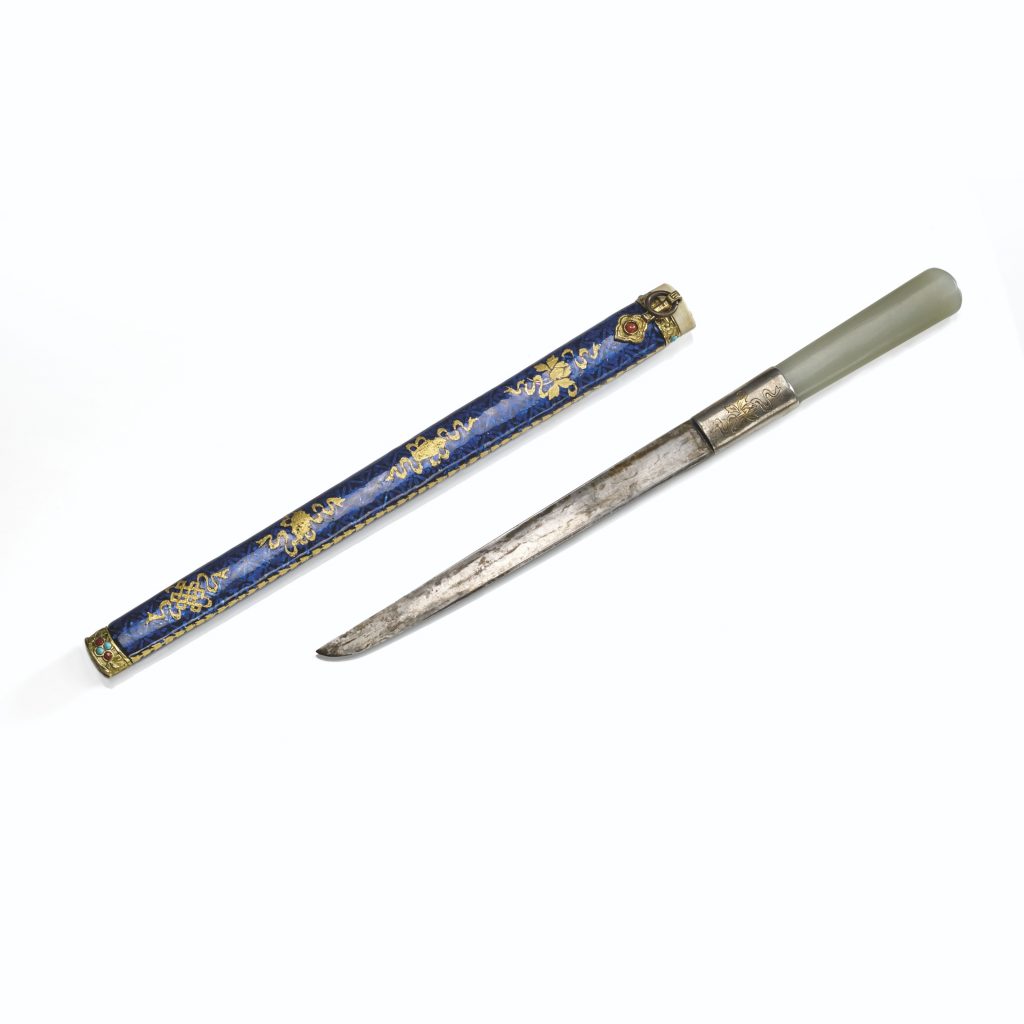
成交價 EUR 12,500
估價 EUR 10,000 – EUR 15,000
清十八世紀 藍透明琺琅嵌玉及象牙刀
A JADE, BASSE-TAILLE CANTON ENAMEL AND IVORY KNIFE
CHINA, QING DYNASTY, 18TH CENTURY
Longueur: 32 cm. (12 ¾ in.)
來源
意大利私人舊藏
狀況報告
We have sought to record changes in the condition of this piece acquired after its initial manufacture.
The blade is in good overall condition.
The scabbard is in good overall condition.
There is some minute wear to the surface of the scabbard overall and light wear to the gilding and to the enamels.
There is a crack to the ivory ring.
There is some light wear to the jade handle.
参考:佳士得
14 9月 2017 | 現場拍賣 13751
中國瓷器及工藝精品
拍品 1033 清 灰玉鎏金刀
A PALE GREYISH-WHITE JADE SCABBARD AND A GILT-METAL-HANDLED DAGGER
18TH CENTURY
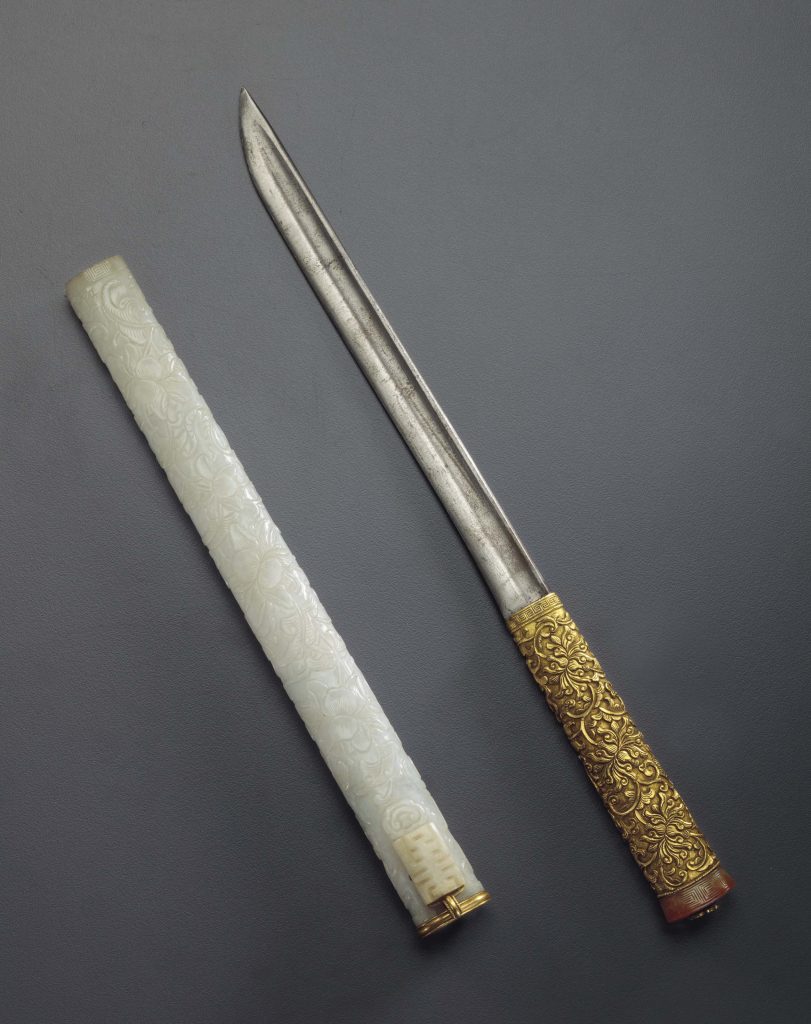
成交價 USD 56,250
估價 USD 20,000 – USD 30,000
A PALE GREYISH-WHITE JADE SCABBARD AND A GILT-METAL-HANDLED DAGGER
18TH CENTURY
The jade scabbard is carved with dense leafy floral scroll between key-fret borders, and has a shou character-form knob on one side fitted with a small gilt-metal ring for attachment. The gilt-metal hilt is similarly decorated and is fitted with an agate pommel decorated with further key fret.
13 5/8 in. (34.5 cm.) long
來源
Millicent Rogers (1902-1953) Collection.
Arturo Peralta Ramos Jr. (1928-2015) Collection, New York.
狀況報告
We have sought to record changes in the condition of this piece acquired after its initial manufacture.
– the end of the scabbard is missing
– v-shaped chip and small nicks to the end of the scabbard
– small nicks and tarnish on the blade
– expected wear to the gilt decoration
拍品專文
A very similar imperial gilt-bronze-handled dagger, but with a white jadeite scabbard, was sold at Christie’s Hong Kong, 30 November 2011, lot 3223.
参考:南京博物馆藏品
清末蒙古钢刀
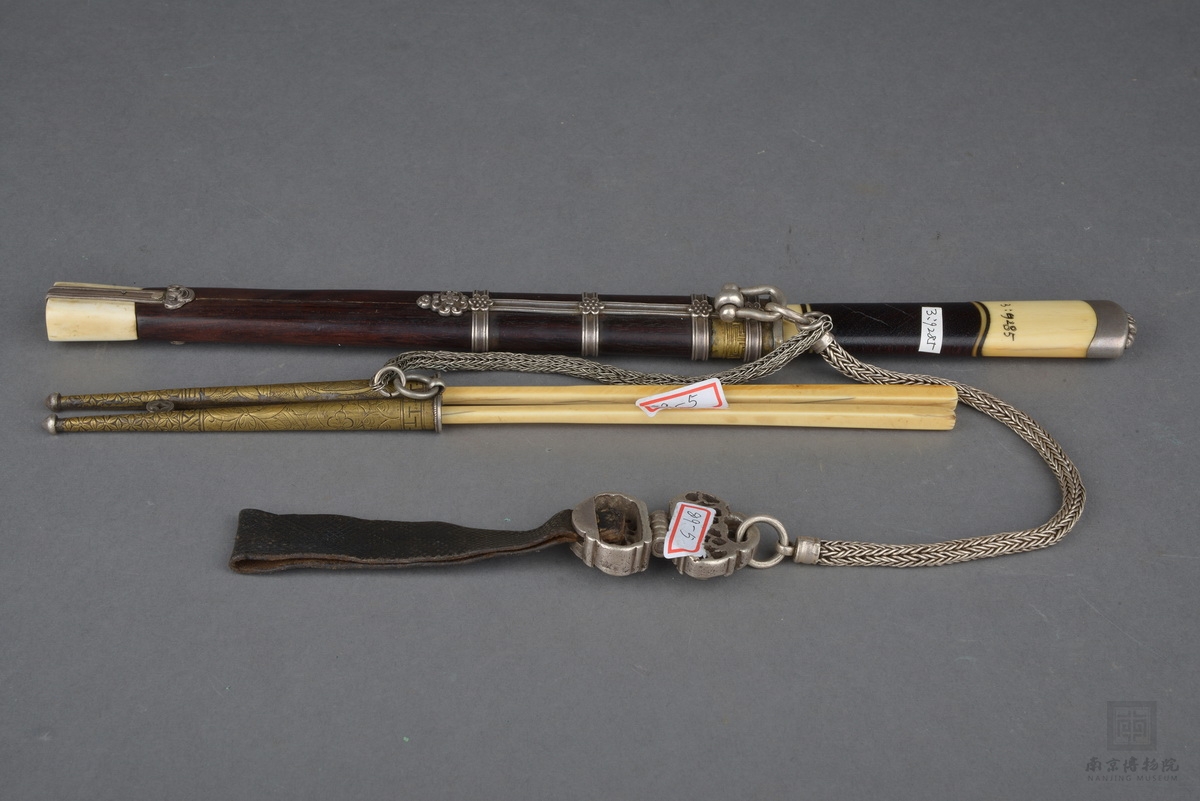
清末蒙古钢刀
通长37.6 厘米
参考:佳士得
16 3月 2017 | 現場拍賣 12900
中國瓷器及工藝精品
拍品 1074
A WHITE JADE LETTER OPENER AND SHEATH
PROPERTY FROM THE WU MAODING FAMILY COLLECTION
清十八世紀 白玉柄裁紙刀及刀鞘
18TH CENTURY

成交價USD 68,750
估價USD 8,000 – USD 12,000
細節
清十八世紀 白玉柄裁紙刀及刀鞘
9 ¼ in. (23.5 cm.) long
來源
Wu Maoding (1850-1928) Collection, and thence by descent within the family.
参考:佳士得
29 11月 2011 | 現場拍賣 2891
重要中國瓷器及工藝精品 I 及 II
拍品 3223
A VERY RARE IMPERIAL GILT-BRONZE HANDLED DAGGER WITH WHITE JADEITE SCABBARD
THE PROPERTY OF AN IMPORTANT PRIVATE COLLECTOR
清初 御製鎏金銅柄白翡翠鞘刀
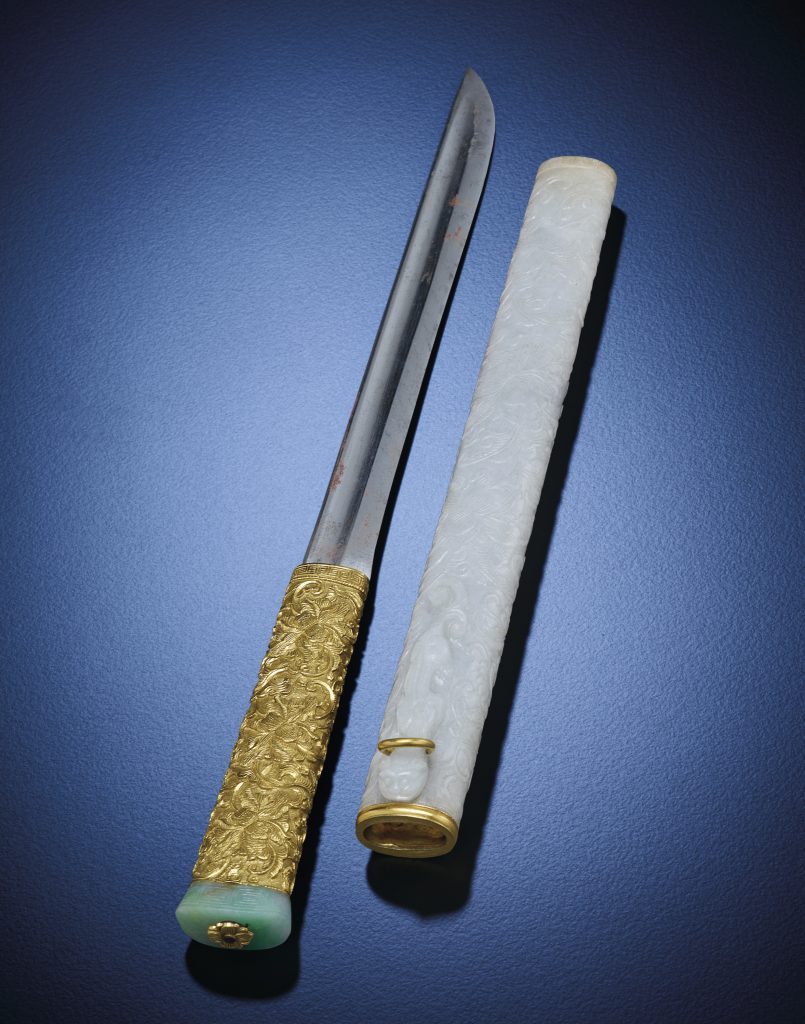
清初 御製鎏金銅柄白翡翠鞘刀
成交價 HKD 2,420,000
估價 HKD 2,000,000 – HKD 3,000,000
清初 御製鎏金銅柄白翡翠鞘刀
細節
刀柄扁圓,銅鎏金,鏨刻纏枝蓮紋。前銳後曲剛刃。白翡翠鞘,紋飾與首柄一致,上浮雕螭龍一條,龍頸穿孔。
此刀作工精細,用料考究,以白翡翠鞘,鎏金銅手柄,襯同類紋飾,可見十八世紀精緻的工藝,是珍貴華麗的民俗用具。
此刀1997年9月23日於紐約蘇富比拍賣,拍品11號;2009年4月8日於香港蘇富比拍賣,拍品1704號。
來源
Previously Sotheby’s New York, 23rd September 1997, lot 11; and sold again at Sotheby’s Hong Kong, 8 April 2009, lot 1704
狀況報告
– In good overall condition.
– The blade with some signs of oxidization.
拍品專文
It is very rare to find a white jadeite scabbard so intricately crafted with a matching gilt-bronze handle, which represents a fine example of the high standards of artistic production achieved in the 18th century. Compare a knife of this type with a jade handle and an intricately carved wood scabbard depicting a flowering lotus scroll, formerly in the collection of Dr. Ip Yee, included in the exhibition Bamboo and Wood Carvings of China and the East, Spink and Son Ltd., London, 1979, cat. no. 277, and sold at Sotheby’s Hong Kong, 19 November 1984, lot 64; another with jade handle and a carved bamboo scabbard, sold at Christie’s New York, 21st September 2004, lot 76; and a pair of slightly smaller knives with carved jade handles and scabbards, sold at Sotheby’s London, 7th June 1994, lot 138. A similar gold knife with a white jade handle and inlaid gold sheath was included in the exhibition Splendours of China’s Forbidden City, The Field Museum, Chicago, 2004, illustrated in the Catalogue, no. 248; and is pictured in situ, no. 250.
The use of personal knives at meals was a mark of Manchu identity. Manchu men were supposed to cut their meat themselves so as to not fall into the decadent Han Chinese habit of eating their meat pre-cut. When eating sacrificial pork, women were also expected to cut up their own meat. It appeared that knives with other associated eating utensils formed part of the dowries of princesses and maidservants, cf. ibid., 2005, pp. 197-201.
参考: 佳士得香港有限公司
2017年春季拍卖会 2017-05-31
中国宫廷御制艺术精品
重要中国瓷器及工艺精品
LOT号: 3033 清乾隆 文竹贴染色象牙刀鞘及镶白玉柄刀

拍品信息
尺寸 长34.4cm
创作年代 清乾隆
估价 HKD 700,000-900,000
成交价 流拍
来源
斯宾克,伦敦,1986年
Adrian Joseph珍藏
Ashfield珍藏
香港邦瀚斯,2013年5月26日,拍品303号
此刀造工精致,结合白玉、象牙、文竹等贵重材料,应为王公贵冑所用。其中刀鞘中央的象牙朵花纹实为内藏牙签,更是匠心独运。可参考北京故宫博物院藏一把刀,刀锋为象牙,刀鞘及柄为花卉纹文竹,见2009年深圳出版故宫博物院藏文物珍品大系《文物》,图版171号。
参考:纽约大都会博物馆
蒙古刀具餐具耳勺
Knife with Sheath, Chopsticks, and Earspoon

Knife with Sheath, Chopsticks, and Earspoon

Knife with Sheath, Chopsticks, and Earspoon
18th–19th century
Chinese
Object Details
Date:18th–19th century
Culture:Chinese
Medium:Steel, wood, ivory, brass, gold
Dimensions:Knife (a); L. with sheath 12 7/8 in. (32.7 cm); L. without sheath 10 3/8 in. (26.4 cm); W. 1/2 in. (1.3 cm); Wt. 0.9 oz. (25.5 g); sheath (b); Wt. 1 oz. (28.3 g); chopstick (c); L. 10 1/2 in. (26.7 cm); W. 3/16 in. (0.5 cm); Wt. 1.3 oz. (36.9 g); chopstick (d); L. 10 1/2 in. (26.7 cm); W. 3/16 in. (0.5 cm); Wt. 1.4 oz. (39.7 g); earspoon (e); L. 3 in. (7.6 cm)
Classification:Knives
Credit Line:Bequest of George C. Stone, 1935
Accession Number:36.25.990a–e
Provenance
George Cameron Stone, New York (by 1934–d. November 18, 1935; his bequest to MMA).
References
Stone, George Cameron. A Glossary of the Construction, Decoration and Use of Arms and Armor in All Countries and in All Times, Together with Some Closely Related Subjects. Portland, ME: Southworth Press, 1934. p. 631, fig. 803, no. 5.
Timeline of Art History
Timelines
Central and North Asia, 1600-1800 A.D.
Central and North Asia, 1800-1900 A.D.
China, 1600-1800 A.D.
China, 1800-1900 A.D.
参考:纽约大都会博物馆
Knife with Sheath, Chopsticks and Belt Loop, Steel, wood, ebony, ivory, silver, brass, leather, coral, Chinese, Manchuria or Mongolian
满族或蒙古佩刀



Steel, wood, ebony, ivory, silver, brass, leather, coral; Knife (a); L. with sheath 11 3/4 in. (29.8 cm); L. without sheath 10 1/8 in. (25.7 cm); W. 3/4 in. (1.9 cm); Wt. 2.2 oz. (62.4 g); sheath (b); Wt. 7.7 oz. (218.3 g); chopsticks (c, d); L. 10 1/4 in. (26 cm); W. 3/16 in. (0.5 cm); Wt. 0.3 oz. (8.5 g)
The Metropolitan Museum of Art, New York, Bequest of George C. Stone, 1935 (36.25.988a–d) 美国大都会博物馆 满族或蒙古佩刀
ca. 1750–1900
Chinese, Manchuria or Mongolian
Object Details
Date:ca. 1750–1900
Culture:Chinese, Manchuria or Mongolian
Medium:Steel, wood, ebony, ivory, silver, brass, leather, coral
Dimensions:Knife (a); L. with sheath 11 3/4 in. (29.8 cm); L. without sheath 10 1/8 in. (25.7 cm); W. 3/4 in. (1.9 cm); Wt. 2.2 oz. (62.4 g); sheath (b); Wt. 7.7 oz. (218.3 g); chopsticks (c, d); L. 10 1/4 in. (26 cm); W. 3/16 in. (0.5 cm); Wt. 0.3 oz. (8.5 g)
Classification:Knives
Credit Line:Bequest of George C. Stone, 1935
Accession Number:36.25.988a–d
Provenance
George Cameron Stone, New York (by 1934–d. November 18, 1935; his bequest to MMA).
References
Stone, George Cameron. A Glossary of the Construction, Decoration and Use of Arms and Armor in All Countries and in All Times, Together with Some Closely Related Subjects. Portland, ME: Southworth Press, 1934. p. 631, fig. 803, no. 1.
Timeline of Art History
Timelines
Central and North Asia, 1600-1800 A.D.
Central and North Asia, 1900 A.D.-present
China, 1600-1800 A.D.
China, 1900 A.D.-present
参考:参考:苏富比
08 十月 2013 • 香港
拍賣編號: HK0477
拍品 3155
清乾隆 御製飾金嵌珊瑚鋼刃佩刀 連金纍絲嵌綠松石刀鞘 《乾隆年製》款
FINE CHINESE CERAMICS AND WORKS OF ART
08 OCTOBER 2013 | 2:00 PM HKT
HONG KONG
3155 A RARE IMPERIAL HUNTING KNIFE WITH GOLD AND TURQUOISE
MARK AND PERIOD OF QIANLONG


Estimate 2,000,000 — 3,000,000 HKD
描述
清乾隆 御製飾金嵌珊瑚鋼刃佩刀 連金纍絲嵌綠松石刀鞘 《乾隆年製》款
A RARE IMPERIAL HUNTING KNIFE WITH GOLD AND TURQUOISE
MARK AND PERIOD OF QIANLONG
《乾隆年製》款
TURQUOISE, BUFFALO HORN, CORAL
overall 29.2 cm., 11 1/2 in., the gold tested as 18K.
已測定為18K金
the variegated amber and brown-coloured buffalo horn hilt bound at either end with a beaded gold band incised on top to resemble twisted wire and inlaid with small sections of coral, the blade of steel and damascene gilding, inscribed on the spine of the knife in inlaid gold wire with the four-character mark Qianlong nianzhi, the gilt metal scabbard of slightly tapered form densely decorated on both side in diaper pattern with further turquoise cabochons, the ends similarly bound in a gilt band inset with turquoise, one side with a gilt loop finely chased with a lion head and linked with a small loose ring for attachment, further thread with yellow silk tassel embellished with coral and mother-of-pearl beads
overall 29.2 cm., 11 1/2 in., the gold tested as 18K.
The turquoise tip of the scabbard and the section of coral on the pommel of the knife are likely to be later replacements, as well as some of the turquoise or coral pieces on the sheath and mounting, but overall the condition is very good with most of the inlays and gilding remaining intact. The horn handle is well polished with some natural veining on one side. There is some oxidation to the blade as visible on the photo but the blade remains otherwise very sharp.
CATALOGUE NOTE
Knife hilts made of horn, gold and coral are rare, although a comparable knife with a rhinoceros horn sheath carved with the design of dragons among clouds inlaid in turquoise from the collection of Dr. Ip Yee was sold in these rooms, 19th November 1984, lot 63, and later again from The Water, Pine and Stone Retreat Collection on 8th October 2009, lot 1817, and illustrated in Thomas Fok, Connoisseurship of Rhinoceros Horn carving in China, Hong Kong, 1999, pl. 180. Another one from the Qing Court collection and still in Beijing, is published in The Complete Collection of Treasures of the Palace Museum. Bamboo, Wood, Ivory and Rhinoceros Horn Carving, Hong Kong, 2002, pl. 211. Compare also another Qianlong marked hunting knife with a closely related sheath, sold in these rooms, 8th April 2010, lot 1810. The exceptional workmanship and highly decorative quality of these knives suggest they are products of the Palace Workshop where military and hunting weapons were made for the emperor and his family.
Knives of this type appear to originally have been hunting knives which were designed for use in the wilderness. Its function was altered to a degree, although it continued to be used on hunts, when it became part of the Manchu ceremonial attire as well as being used at meals, an indication of the bearer’s Manchu identity. Manchu men cut their meat themselves so as not to fall into the decadent Han habit of eating their meat pre-cut.
Compare a gold knife with a scabbard inlaid with turquoise, coral and lazurite, the handle of carved jade, inscribed with a Qianlong reign mark and of the period, included in the exhibition Splendours of China’s Forbidden City, The Field Museum, Chicago, 2004, cat. no. 248, where it is noted that when eating sacrificial pork, women were also expected to cut their own meat. The same knife appears as part of a table setting in situ, which is a reconstruction of an imperial banquet table, ibid., pl. 230.
參考: 坠火镰蒙古要腰刀
1 简介
蒙古刀是蒙古族工艺品中最具有代表性的馈赠礼品之一。蒙古人民信奉长生天。在那个古老的传说中,美丽的长生天赐予蒙古人“三大宝”和“三小宝”。其中“三大宝”为:蒙古包,草原,牛羊。三小宝为:蒙古刀,马头琴,奶酪工艺。蒙古人将“六宝”传承至今。精美绝伦的蒙古刀延续并记载着蒙古人的勇敢,智慧和辉煌的历史;在和平年代的今天,蒙古刀承载的是对永久和平的渴望,蒙古人的艺术成就和对祖国各族人民的深厚祝福。在蒙古人心目中,蒙古刀是长生天所赐的圣物,因此它会带给拥有蒙古刀的朋友好运和平安。
蒙古刀是蒙古族最为典型的工艺品。 蒙古刀既是蒙古成年男子防身或宰杀牛羊、吃手抓肉必备的用具,又是一种不可缺少的独特的装饰艺术品。蒙古族男子在腰带右侧佩戴蒙古刀,和鼻烟壶、火镰一起挂,显得格外威风,更加表现出男性英武、潇洒的性格和风采。 据说,不戴蒙古刀的男子汉,妇女们多看不起。蒙古刀并不是械斗的工具,在牧区很少打架动刀子的。

2 工艺
蒙古工匠最拿手的技术就是做刀。蒙古刀刀身一般采用优质钢打制,长十几厘米至数十厘米不等。刀柄和刀鞘有钢制、银制、木制、牛角制、骨头制等多种,表面有精美的花纹,有的还填烧珐琅,镶嵌宝石。近年研制生产的驼骨彩绘鞘蒙古刀成为工艺珍品,畅销海外。还有工艺精湛、实用的马头弯刀。蒙古刀种类繁多,造型各异,大小不一。主要用来杀羊吃肉,也是男子汉的佩饰。刃用好钢,柄用牛角、红木做成、实用而漂亮,鞘中有孔,可插ㄨㄚ或驼骨筷子。鞘上有环,环上缀有丝线带子。丝线带子一头有环,可以挂在胯上;一头编有蝴蝶结,下面是穗子;一头有勃勒。 勃勒是一种银子打的圆形饰件,上面有花纹,中间嵌有珊瑚大珠。蒙古刀的勃勒,也有用绸缎刺绣的。 刀鞘用金、银、铜做成,上刻龙、虎、兽头、云纹图案,ㄨㄚ筷的大头一端还套有银束子。民间传说,饭菜下毒用银束子就可以试出来。

3 分类
蒙古人将蒙古刀分为六大系列:勇,智,礼,亲,忠,姻。勇:扶正压邪,阳刚之美。智:正气冲天,运筹帷幄。礼:和中无邪,宾朋连绵。亲:镇宅辟邪,全家平安。忠:引领霸气,得到多助。姻:正气融通,两情厢愿.
精美绝伦的蒙古刀,延续并记载着伟大的蒙古人的勇敢、智慧与辉煌! 在蒙古人的心中,蒙古刀是腾格里所赐的圣物,像征着给自己和身边朋友带来运气和平安,它不但是防身之物,还是镇宅避邪之宝。 在和平年代今天,蒙古刀承载的是勤劳、和平、幸福的祝福。
參考:滿清遊牧民族隨身攜帶的套裝利器,餐刀/筷箸
在清朝時期,用刀和筷子(有時還有其他一些餐具)的餐具隨處都是。在乾隆皇帝的統治下,所有的滿族人和蒙古人都必須佩戴這些套裝。

理由是,這些刀具促進了傳統的遊牧式進食方式,這與漢人的飲食習慣形成了鮮明的對比。在這種方法中,食物被預先切成小塊,可以用筷子吃。為了保留滿清蒙古人的這種生活方式,因此肉被事先切好端上來食用是不被允許的。因此,所有滿族人和蒙古人都要帶這樣一套餐具,保留自己的傳統習俗。

這種高質量的套裝是用一種翠綠色的皮革覆蓋的鞘,包含刀和兩根骨筷。青銅配件仍有一些原始的鍍金完好無損。這把刀由優質的鋼片製成,有清晰的層狀結構,有堅硬的高碳邊緣。
骨制手柄一面雕刻花卉圖案,另一面雕刻有道教神仙的韓湘子的形象。在他的能力之中,能夠使花朵立即開花(因此手柄的反面刻有花朵),能夠撫慰野生動物。同時也是音樂家的守護神。









極其罕見的是,這把刀還有一個絲綢的外套。黑色的外套袋子上裝飾著各種各樣的絲綢花朵。邊緣用白色、藍色和淺藍色交織在一起。一側有一根穿著兩顆粉紅色珠子的繩子。
這把刀品相上佳,在刀刃上沒有過度磨削,在骨柄上有一個小的損失,但並不影響整體美觀。

![[临渊阁]天地一家春](https://www.antiquekeeper.ca/wp-content/uploads/2023/03/cropped-Asian-Art-Wallpaper-Painting3-6-1.jpg)

